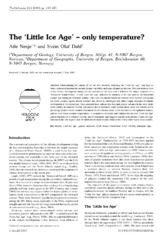| dc.description.abstract | Understanding the climate of the last few centuries, including the 'Little Ice Age', may help us better understand modern-day natural climate variability and make climate predictions. The conventional view of the climate development during the last millennium has been that it followed the simple sequence of a 'Mediaeval Warm Period', a cool 'Little Ice Age' followed by warming in the later part of the nineteenth century and during the twentieth century. This view was mainly based on evidence from western Europe and the North Atlantic region. Recent research has, however, challenged this rather simple sequence of climate development in the recent past. Data presented here indicate that the rapid glacier advance in the early eighteenth century in southern Norway was mainly due to increased winter precipitation: mild, wet winters due to prevailing 'positive North Atlantic Oscillation (NAO) weather mode' in the first half of the eighteenth century; and not only lower summer temperatures. A comparison of recent mass-balance records and 'Little Ice Age' glacier fluctuations in southern Norway and the European Alps suggests that the asynchronous 'Little Ice Age' maxima in the two regions may be attributed to multidecadal trends in the north–south dipole NAO pattern. | en_US |
